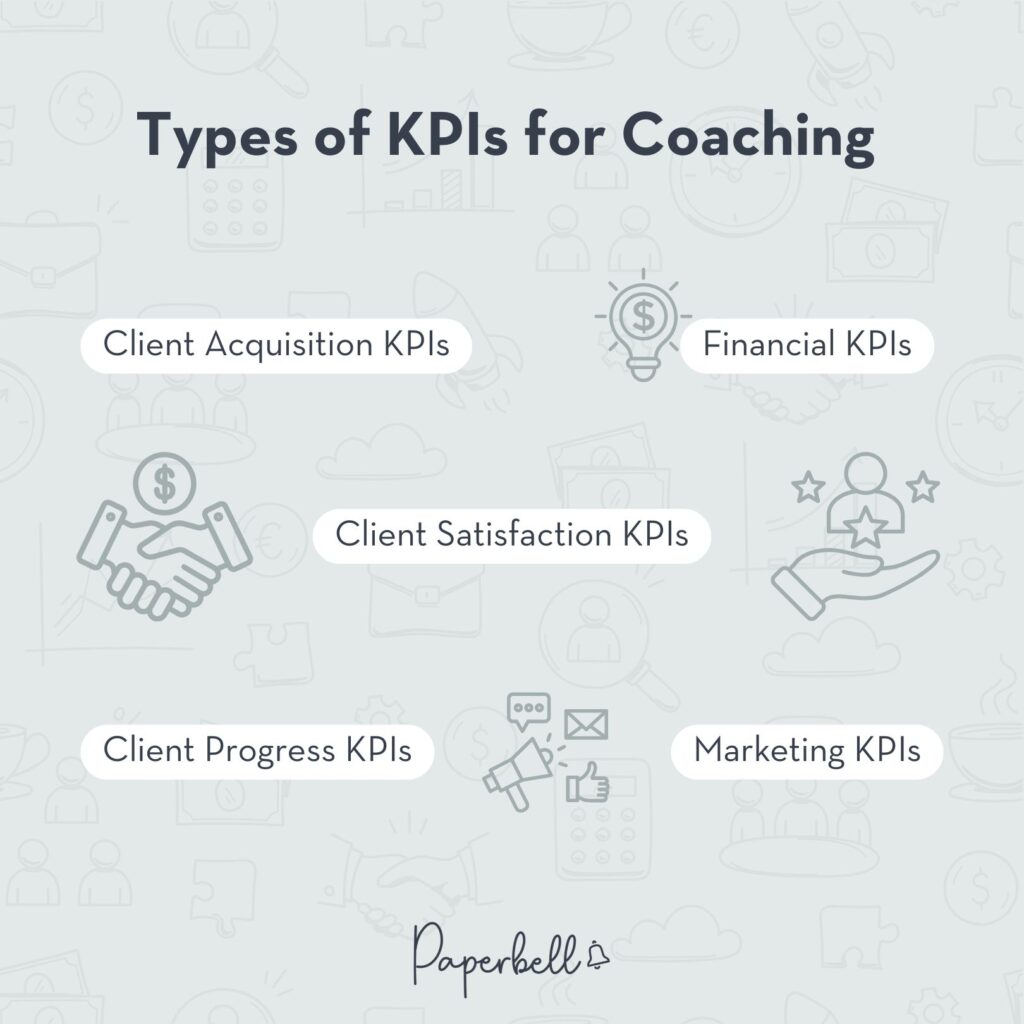Running a coaching business isn’t just about delivering great sessions; it’s about making sure your business is constantly moving forward.
Are you bringing in enough clients? Is your revenue where you want it to be? Are your marketing efforts paying off?
Without tracking the right numbers, it’s easy to feel stuck, wondering why things aren’t growing the way you expected. That’s why coaches, like any business owner, should rely on key performance indicators (KPIs) to measure progress and make better business decisions.
By tracking the right KPIs, you’ll know exactly what’s working, what needs to change, and how to build the coaching practice you envision with confidence. Let’s break down the most important ones you should pay attention to.
What Are KPIs for Coaching?

KPIs, or Key Performance Indicators, are measurable targets showing how well your coaching business is performing. They help you track progress, spot trends, and make informed decisions instead of guessing what’s working.
Think of them as a roadmap. Without them, you’re driving blind, unsure if your efforts are leading to growth or just keeping you busy. When you track the right KPIs, you get a clear picture of what’s bringing in clients, what’s boosting your revenue, and what areas need improvement.
Some coaches assume that KPIs are only for large businesses or complex operations, but that’s not true. Even as a solo coach, keeping an eye on your numbers helps refine your strategy, improve client retention, and build a more sustainable business.
Now, let’s dive into the most important KPIs that help your coaching business grow.
Client Acquisition KPIs
Bringing in new clients is the lifeblood of your coaching business. If you’re struggling to grow, tracking these KPIs will help you identify where potential clients drop off in the sales process and what’s working to convert them.
1. Discovery Call Booking Rate
This measures how many potential clients book a consultation or discovery call after visiting your website or engaging with your content.
How to track it: Divide the number of discovery calls booked by the number of people who visited your booking page or responded to a CTA (call to action). A low rate may mean your messaging isn’t clear or your offer isn’t compelling enough.
2. Lead-to-Client Conversion Rate
This tracks how many of your leads (people who show interest in your coaching) actually become paying clients.
How to track it: Divide the number of new clients by the number of leads over a set period. If your rate is low, review your sales process: Are you following up consistently? Is your pricing clear?
3. Sales Conversion Rate from Discovery Calls
Not every discovery call turns into a client, but this metric helps you see how effective your calls are in closing sales.
How to track it: Divide the number of clients gained from discovery calls by the total number of calls held. If the rate is low, refine your call structure and address objections more effectively.
Financial KPIs
Tracking your financial metrics ensures your coaching business has a healthy cash flow. These KPIs help you understand where your income comes from, identify trends in it, and make informed decisions about your pricing and expenses. Understanding these financial metrics is especially important if you’re planning future investments or even applying for a loan, since lenders often look at revenue consistency, profit margins, and long-term financial stability. This clarity becomes even more crucial when applying for a secured loan, as lenders carefully evaluate your financial strength before approving assets-backed borrowing.
1. Total Revenue
This is the total income your coaching business generates within a specific period. It gives you a clear picture of the overall business performance.
How to track it: Check your payment processor or accounting software for total revenue over a set period (monthly, quarterly, or annually). If revenue isn’t growing, assess your pricing structure, client retention, or marketing efforts.
2. Revenue Per Coaching Package
This shows which offers generate the most income, helping you refine your services and pricing. It also helps you see whether one-on-one or group coaching, and low or high-ticket offers work better.
How to track it: If you use Paperbell, you can easily track revenue per coaching package on your dashboard without the need to calculate it manually. You can set up as many custom packages as you like with their distinct pricing options and generate landing pages for them automatically, where clients can purchase them.
3. Client Lifetime Value (CLV)
This measures the total revenue a client brings in over their entire relationship with you. Your clients with the highest CLV might either be the most loyal repeat clients or those who purchased your high-ticket offers.
How to track it: Paperbell provides an easy way to track your CLV for each client through your dashboard. If the client was onboarded to Paperbell later, don’t forget to include any previous purchases made outside the platform.
4. Profit Margin
Revenue means little without profitability. This metric ensures your business is financially sustainable.
How to track it: Subtract total expenses from total revenue, then divide by total revenue. If your margin is low, review expenses or consider increasing prices.
Client Satisfaction KPIs
Bringing in new clients is important, but keeping them engaged and helping them achieve their goals is what makes your coaching business truly effective. These KPIs help you measure client satisfaction, retention, and the impact of your coaching.
1. Client Retention Rate
This measures how many clients continue working with you after their initial package ends. A high retention rate indicates strong client satisfaction and long-term business stability.
How to track it: At the end of a program, divide the number of clients who sign up for another package by the total number of clients who completed their initial program. If retention is low, you may consider improving your coaching programs, offering longer-term packages, or refining your follow-up process.
2. Churn Rate
Your churn rate is the opposite of your retention rate: Clients who stop working with you over a specific period. If you focus on ongoing coaching, a high churn rate might indicate issues with client satisfaction, pricing, or perceived value.
How to track it: Divide the number of clients who left by the total number of clients in that period, then multiply by 100. If your churn rate is high, consider refining your packages or checking in with inactive clients to see how you can better support them.
3. Net Promoter Score (NPS)
NPS measures how likely clients are to recommend you on a scale from 0 to 10. This helps gauge overall satisfaction beyond just retention.
How to track it: Send a short survey asking, “How likely are you to recommend my coaching services to a friend?” Clients who rate 9-10 are promoters, 7-8 are passive, and 0-6 are detractors. If your NPS is low, look for patterns in feedback and make necessary improvements.
Client Progress KPIs
1. Client Goal Achievement Rate
Tracking how many clients successfully reach their goals helps you measure your coaching effectiveness.
How to track it: Use pre- and post-coaching assessments, client feedback forms, or progress-tracking tools. If goal achievement is low, evaluate whether your coaching process or the coaching techniques you use need adjustments.
2. Time to First Result
How quickly do your clients start seeing progress? Tracking how long it takes for clients to experience a win—big or small—can help you refine your coaching program for quicker impact.
How to track it: Use client surveys or session notes to monitor when clients first report progress. If results take longer than expected, consider adjusting your session structure, adding accountability check-ins, or creating additional resources to support clients between coaching sessions.
3. Session Completion
Some clients drop off before completing all their sessions in a package, which can impact their results and, unless you charge advance payments, your revenue.
How to track it: In Paperbell, you can check the number of coaching sessions used vs. remaining for each client. If clients aren’t completing their sessions, follow up and assess if they need additional support or accountability.
Marketing KPIs
These KPIs help you measure the effectiveness of your marketing and visibility efforts for your online coaching business.
1. Website Traffic and Conversion

Your website is like your digital storefront. You might have great content, but if visitors aren’t booking discovery calls or signing up for your email list, something’s off.
Use Google Analytics or your website platform to check:
- Total visitors: How many people are coming to your site?
- Conversion rate: What percentage of visitors take action (book a call, download a freebie, or join your email list)?
💡 If your conversion rate is low: Your messaging might not be clear, your CTA might not stand out, or your website might feel overwhelming. Try simplifying your landing page, making your CTA more compelling, or adding testimonials for trust.
2. Email List Engagement
A strong email list is one of the best ways to convert leads into paying clients. It’s not just about how many people sign up but how many actually read and engage with your emails.
Use your email marketing platform (like ConvertKit or Mailchimp) to check:
- New subscribers per month: Are people signing up, or has growth stalled?
- Open rate: Are people even opening your emails? (Good open rates are typically 30% or higher.)
- Click-through rate (CTR): How many people click on links inside your emails?
💡 If engagement is low: Experiment with subject lines, add more storytelling or segment your list to send more personalized content.
3. Lead Generation From Social Media

Posting consistently is great, but if no one interacts with or takes action on your content, it will get lost in the noise. When managed right, social media platforms can be lead-generation tools that attract the right people.
What to look out for:
- Engagement: Check video views, post likes, comments, shares, and saves on the social media platforms you’re active on.
- Direct messages: Are people interacting with your stories or reaching out with questions?
- Leads generated: Use UTM links on each platform to track how many of your leads come from there.
💡 If social media isn’t bringing in leads: Focus on specific advice your target audience can benefit from and use engaging storytelling to grab their attention. You can also experiment with different content formats like fun reels, educational carousels, client transformation stories, or AMAs (ask me anything).
To drive people into your funnel, you can offer a free guide and ask those interested to send you a direct message. Then you can direct them to your landing page where they can download it and join your email list.
How to Use KPIs Effectively
Here’s how you can make the most of the metrics above.
- Don’t track everything; focus on what moves the needle: Select 5-7 KPIs that directly impact the growth of your coaching business and help you make decisions.
- Check your KPIs regularly: Reviewing them quarterly, monthly, or even weekly (for fast-moving metrics) ensures you can make timely adjustments instead of waiting until something goes wrong.
- Use tools that automate tracking: Instead of manually collecting data, use platforms like Paperbell or Google Analytics to monitor your numbers.
- Adjust goals based on trends: If you notice a consistent drop or increase in a KPI, look at what’s changed in your business and adjust your strategy accordingly.
FAQ
What’s the Most Important KPI for New Coaches?
Client acquisition metrics, like discovery call booking rate and lead-to-client conversion rate, are crucial when you start. They help you understand how effectively you’re turning interest into paying clients.
How Many KPIs Should I Track?
Focus on 5–7 key metrics that align with your goals, such as client acquisition, revenue, retention, and marketing effectiveness. Tracking too many can get overwhelming.
How Do I Set Realistic KPI Targets?
Start with industry benchmarks or your past data. Set achievable goals based on your business stage, then adjust as you grow. Aim for steady progress, not perfection.
How to Measure Coaching Performance?
Track client retention, session completion rates, and goal achievement. Collect feedback through surveys and assess progress with pre- and post-coaching evaluations.
A Simple Dashboard That Runs Your Entire Coaching Business

Tracking KPIs doesn’t always mean number crunching in spreadsheets. With the right tools, you can keep an eye on key metrics without the math.
Paperbell’s simple dashboard automatically tracks your revenue for each individual client and package, so you know where to focus your efforts. You can also review session completion, purchase history, discovery calls booked, and more.
Beyond tracking simple data, Paperbell runs your entire coaching practice from your website and surveys to your payments and bookings. Try it now for free and see how it can transform your business.










